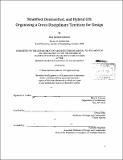Stratified, destratified, and hybrid GIS : organizing a cross-disciplinary territory for design
Author(s)
Carlsson, Moa Karolina
DownloadFull printable version (14.50Mb)
Alternative title
Stratified, destratified, and hybrid Geographic Information System : organizing a cross-disciplinary territory for design
Other Contributors
Massachusetts Institute of Technology. Department of Architecture.
Advisor
George Stiny.
Terms of use
Metadata
Show full item recordAbstract
Although the term Geographic Information System (GIS) is most commonly associated with computer software, the principles of GIS existed long before it was implemented on a computer. This thesis hypothesizes that the computerization of the formerly analogue GIS in the 1960s, which emerged with CGIS and initiatives at the Harvard Laboratory for Computer Graphics and Spatial Analysis, can be read as the establishment of a pre-existing analytical conception of the environment over its synthetic and holistic counterpart. It is often claimed that the analytical nature of computerized GIS was determined by the capabilities and limitations of the digital computer. While this techno-centered trajectory of GIS is fairly well documented, the present thesis aims to open up a new perspective on GIS, by highlighting an alternative history of modeling both natural and artificial geographical information through the Ecological Method of Ian L. McHarg, the late Emeritus Professor of Landscape Architecture and Planning at the University of Pennsylvania. In the thesis, these two parallel trajectories of analytical and synthetic/holistic methods are examined through two general schemes by which cross-disciplinary geographical information is organized, from the perspective of a general user. The two models, henceforth characterized as "stratified" and "destratified" models, both deal with the linking of cross-disciplinary and geographically referenced information, differ in logic and user interaction, but are argued to be equally computational. The motivation behind the present research is the realization that, to date, the technological aids available for design in cross-disciplinary and dynamic environments do not suffice. Whispers of a new design-oriented platform, which one might characterize as "Landscape Information Modeling" or "LIM," are starting to be heard, and the main purpose of this thesis is to contribute to such discussion.
Description
Thesis (S.M.)--Massachusetts Institute of Technology, Dept. of Architecture, 2013. "June 2013." Cataloged from PDF version of thesis. Includes bibliographical references (p. 119-123).
Date issued
2013Department
Massachusetts Institute of Technology. Department of ArchitecturePublisher
Massachusetts Institute of Technology
Keywords
Architecture.